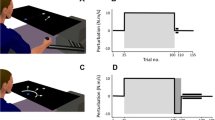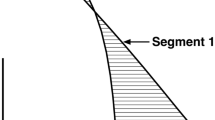Abstract
During trunk-assisted reaching to targets placed within arm’s length, the influence of trunk motion on the hand trajectory is compensated for by changes in the arm configuration. The role of proprioception in this compensation was investigated by analyzing the movements of 2 deafferented and 12 healthy subjects. Subjects reached to remembered targets (placed ~80° ipsilateral or ~45° contralateral to the sagittal midline) with an active forward movement of the trunk produced by hip flexion. In 40% of randomly selected trials, trunk motion was mechanically blocked. No visual feedback was provided during the experiment. The hand trajectory and velocity profiles of healthy subjects remained invariant whether or not the trunk was blocked. The invariance was achieved by changes in arm interjoint coordination that, for reaches toward the ipsilateral target, started as early as 50 ms after the perturbation. Both deafferented subjects exhibited considerable, though incomplete, compensation for the effects of the perturbation. Compensation was more successful for reaches to the ipsilateral target. Both deafferented subjects showed invariance between conditions (unobstructed or blocked trunk motion) in their hand paths to the ipsilateral target, and one did to the contralateral target. For the other deafferented subject, hand paths in the two types of trials began to deviate after about 50% into the movement, because of excessive elbow extension. In movements to the ipsilateral target, when deafferented subjects compensated successfully, the changes in arm joint angles were initiated as early as 50 ms after the trunk perturbation, similar to healthy subjects. Although the deafferented subjects showed less than ideal compensatory control, they compensated to a remarkably large extent given their complete loss of proprioception. The presence of partial compensation in the absence of vision and proprioception points to the likelihood that not only proprioception but also vestibulospinal pathways help mediate this compensation.





Similar content being viewed by others
References
Adamovich SV, Archambault PS, Ghafouri M et al. (2001) Hand trajectory invariance in reaching movements. Exp Brain Res 138:288–303
Baldissera F, Cavallari P, Tassone G (1990) Effects of transmastoid electrical stimulation on the triceps brachii EMG in man. Neuroreport 1(3–4):191–193
Bernstein NA (1967) The coordination and regulation of movements. Pergamon, Oxford
Botzel K, Feise P, Kolev O, Krafczyk S, Brandt T (2001) Postural reflexes evoked by tapping forehead and chest. Exp Brain Res 138:446–451
Bresciani JP, Blouin J, Popov K et al. (2002) Galvanic vestibular stimulation in humans produces online arm movement deviations when reaching toward memorized visual targets. Neurosci Lett 318(1):34–38
Britton TC, Day BL, Brown P et al. (1993) Postural electromyographic responses in the arm and leg following galvanic vestibular stimulation in man. Exp Brain Res 94(1):143–151
Cooke JD, Brown S, Forget R, Lamarre Y (1985) Initial agonist burst duration changes with movement amplitude in a deafferented patient. Exp Brain Res 60:184–187
Day BL, Cole JC (2002) Vestibular-evoked postural responses in the absence of somatosensory information. Brain 125:2081–2088
Feldman AG, Orlovsky GN (1972) The influence of different descending systems on the tonic stretch reflex in the cat. Exp Neurol 37:481–494
Forget R, Lamarre Y (1987) Rapid elbow flexion in the absence of proprioceptive and cutaneous feedback. Hum Neurobiol 6:27–37
Ghafouri M, Archambault PS, Adamovich SV, Feldman AG (2002) Pointing movements may be produced in different frames of reference depending on the task demand. Brain Res 929(1):117–128
Ghez C, Gordon J, Ghilardi MF (1995) Impairments of reaching movements in patients without proprioception. II. Effects of visual information of accuracy. J Neurophysiol 73:1;361–372
Gordon J, Ghilardi MF, Ghez C (1995) Impairments of reaching movements in patients without proprioception. I. Spatial errors. J Neurophysiol 73:1;347–360
Gracco VL, Abbs JH (1985) Dynamic control of the perioral system during speech: kinematic analyses of autogenic and nonautogenic sensorimotor processes. J Neurophysiol 54(2):418–432
Gribble PL, Ostry DJ (1998) Independent coactivation of shoulder and elbow muscles. Exp Brain Res 123:355–360
Gribble PL, Ostry DJ (1999) Compensation for interaction torques during single- and multijoint limb movement. J Neurophysiol 82:2310–2326
Guitton D (1992) Control of eye-head coordination during orienting gaze shifts. Trends Neurosci 15(5):174–179
Horak FB, Hlavacka F (2001) Somatosensory loss increases vestibulospinal sensitivity. J Neurophysiol 86:575–585
Horak FB, Shupert CL, Dietz V, Horstmann G (1994) Vestibular and somatosensory contributions to responses to head and body displacements in stance. Exp Brain Res 100:93–106
Horak FB, Lamarre Y, Macpherson JM, Shupert C, Henry SM (1996) Postural control associated with total body somatosensory loss. Soc Neurosci Abstr 22:1632
Inglis JT, Macpherson JM (1995) Bilateral labyrinthectomy in the cat: effects on the postural response to translation. J Neurophysiol 73(3):1181–1191
Inglis TJ, Shupert CL, Hlavacka F, Horak FB (1995) Effect of galvanic vestibular stimulation on human postural responses during support surface translations. J Neurophysiol 73(2):895–901
Johnston JL, Sharpe JA (1994) The initial vestibular-ocular reflex and its visual enhancement and cancellation in humans. Exp Brain Res 99(2):302–308
Karnath HO, Sievering D, Fetter M (1994) The interactive contribution of neck proprioception and vestibular stimulation to subjective “straight ahead” orientation in man. Exp Brain Res 101:140–146
Lajoie Y, Paillard J, Teasdale N, Bard C, Fleury M, Forget R, Lamarre Y (1992) Mirror drawing in a deafferented patient and normal subjects: visuoproprioceptive conflict. Neurology 42(5):1104–1106
Lajoie Y, Teasdale N, Cole JD et al. (1996) Gait of a deafferented subject without large myelinated sensory fibers below the neck. Neurology 47:109–115
Lashley K S (1951) The problem of serial order in behavior. In: Jeffress (ed) Cerebral mechanisms in behavior. Wiley, New York
Latash ML, Scholz JP, Schöner G (2002) Motor control strategies revealed in the structure of motor variability. Exerc Sport Sci Rev 30:26–31
Levin MF, Lamarre Y, Feldman AG (1995) Control variables and proprioceptive feedback in fast single-joint movement Can J Physiol Pharmacol 73(2):316–30
Li L, Steidl S, Yeomans JS (2001) Contributions of the vestibular nucleus and vestibulospinal tract to the startle reflex. Neuroscience 106(4):811–821
Lobel E, Kleine JF, Le Bihan D, Leroy-Willig A, Berthoz A (1998) Functional MRI of galvanic vestibular stimulation. J Neurophysiol 80:2699–2709
Ma S, Feldman AG (1995) Two functionally different synergies during arm reaching movements involving the trunk. J Neurophysiol 73:2120–2122
Mars F, Archambault PS, Paquet N, Feldman AG (2003) Vestibular contribution to arm-trunk coordination during pointing. Exp Brain Res 150:515–519
Nougier V, Bard C, Fleury M et al. (1996) Control of single-joint movements in deafferented patients: evidence for amplitude coding rather than position control. Exp Brain Res 109:473–482
Olausson H, Lamarre Y, Backlund H et al. (2002) Unmyelinated tactile afferents signal touch and project to insular cortex. Nat Neurosci 5:900–904
Pigeon P, Feldman AG (1998) Compensatory arm–trunk coordination in pointing movements is preserved in the absence of visual feedback. Brain Res 802:274–280
Pigeon P, Yahia LH, Mitnitski AB, Feldman AG (2000) Superposition of independent units of coordination during pointing movements involving the trunk with and without visual feedback. Exp Brain Res 131(3):336–349
Rossi E, Mitnitski A, Feldman AG (2002) Sequential control signals determine arm and trunk contributions to hand transport during reaching in humans. J Physiol (Lond) 538(2):659–671
Sainburg RL, Poizner H, Ghez C (1993) Loss of proprioception produces deficits in interjoint coordination. J Neurophysiol 70:5;2135–2147
Sainburg RL, Ghilardi MF, Poizner H, Ghez C (1995) Control of limb dynamics in normal subjects and patients without proprioception. J Neurophysiol 73:2;820–835
Sainburg RL, Ghez C, Kalakanis D (1999) Intersegmental dynamics are controlled by sequential anticipatory, error correction, and postural mechanisms. J Neurophysiol 81:3;1045–41056
Stapley PJ, Ting LH, Hulliger M, Macpherson JM (2002) Automatic postural responses are delayed by pyridoxine-induced somatosensory loss. J Neurosci 22(14):5803–5807
Tunik E, Poizner H, Levin MF et al. (2001) Role of proprioception in arm–trunk coordination during reaching with unexpected perturbation of the trunk (abstract). Program No. 302.10 Abstract Viewer/Itinerary Planner. Society for Neuroscience, Washington, DC
Watson SRD, Colebatch JG (1998a) Vestibular-evoked electromyographic responses in soleus: a comparison between click and galvanic stimulation. Exp Brain Res 119:504–510
Watson SRD, Colebatch JG (1998b) Vestibulocollic reflexes evoked by short-duration galvanic stimulation in man. J Neurophysiol 513(2):587–597
Weeks RA, Gerloff C, Dalakas M, Hallett M (1999) PET study of visually and non-visually guided finger movements in patients with severe pan-sensory neuropathies and healthy controls. Exp Brain Res 128(3):291–302
Welgampola MS, Colebatch JG (2001) Vestibulospinal reflexes: quantitative effects of sensory feedback and postural task. Exp Brain Res 130:345–353
Wilson V, Maeda M (1974) Connections between semicircular canals and neck motoneurons in the cat. J Neurophysiol 37:346–357
Wilson VJ, Zarzecki P, Shor RH et al. (1999) Cortical influences on the vestibular nuclei of the cat. Exp Brain Res 125:1–13
Acknowledgements
The authors thank Philippe Archambault for programming assistance. Special thanks to deafferented subjects C.F. and G.L. for participating. Research supported by NIH grant NS36449 (H.P.) and by grants from the Canadian Institutes for Health Research (CIHR) and from Les Fonds pour la Formation de Chercheurs et l’Aide à la Recherche (FCAR; Y.L., A.G.F., and M.F.L.).
Author information
Authors and Affiliations
Corresponding author
Rights and permissions
About this article
Cite this article
Tunik, E., Poizner, H., Levin, M.F. et al. Arm–trunk coordination in the absence of proprioception. Exp Brain Res 153, 343–355 (2003). https://doi.org/10.1007/s00221-003-1576-4
Received:
Accepted:
Published:
Issue Date:
DOI: https://doi.org/10.1007/s00221-003-1576-4




